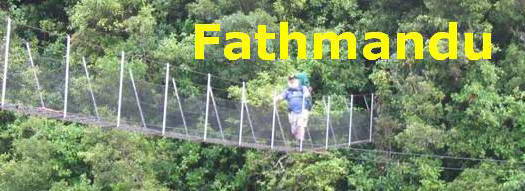
Many thanks for permission to use graphics from their software and toposheets |
 |
|
10 April 2008 Swanson Pipeline Track page 2 This is a putaputaweta. Maori were said to believe that weta burrowed into the wood to make homes. Later research suggests that, as usual, the wetas make use of holes that are already present, but the name remains.
Another collection of small shrubs - mingimingi and hangehange. I'm not a student of Maori language, but I wonder whether the repeated syllable name so common among plant names - kawakawa, kohekohe, ramarama, mangemange, etc, is peculiar to plants or whether it has a wider application.
It's comfortable and, by now, attractive walking, though it might be slippery in the wet.
A patch of lycopodium appears on the left. I have acquaintances up north who derive a small income from their scrubby lifestyle block by harvesting this plant for sale to florists.
Heketara makes it's appearance in the more open and exposed areas of the track. It's one of the tree daisies that tend to occupy the harder, drier, fringes of bush areas. "Daisy" is a technical term for plants of what used to be called the Compositae family but which now goes as Asteraceae. Some of them have "daisy" type flowers, but many have flowers more like a groundsel. Rangiora is another in this family. [New naming conventions stipulate that a family must take its name from a "type" genus within that family. Hence, Compositae and Umbelliferae, names which describe the general flower form, have had to make way for new names.]
The track rises and falls, generally climbing overall.
Up ahead, a decent kauri stands over the rest of the bush around it.
The track is covered with kauri litter just along here. I nudge a green kauri cone with my foot and it quietly falls apart. I'd expected something akin to a pine cone, but these cones behave quite differently.
Here's a narrow leaved lawyer. I'm not sure what to make of this one. The only really narrow-leaved lawyer, R. parvus, is described as having a Wellington and Southern Alps distribution, and the other candidate, R. schmidelioides has leaflets in groups of three to five.
Manhole covers in the middle of tramping tracks are just a little freaky.
Over to the right is a largish heap of gravel, now encrusted with weeds. Now and again one comes across these along the various tracks, as though a project to improve track surface died and was abandoned part way through.
To be sure, there is a quantity of gravel in the track surface along here, but just as often there isn't. the 4WD road gives way to a narrower trail.
Swing low, sweet karaeo..... These nooses are quite common. I wonder at what point whatever passes for consciousness in a supplejack decides it has descended far enough and should probably head upwards again, twisting around its own length. Quite a lot oif supplejack berries around just now, too.
A piece of pink plastic ribbon announces a nearbu poison bait station. Again, we need to appreciate the huge human effort that goes into pest control in our forests, and the difference this makes to the resulting quality of the undergrowth, to birdlife and so forth. A pair of small (I think) black tits has been accompanying me for the last 50 metres or so, but just will not sit still on a sunny branch for long enough for me to get the camera organised.
Nice walking on a beautiful day through dapple shade. We are heading more or less into the sun which can make burnout a problem on many of the photos.
The canopy becomes taller and the track momentarily becomes darker.
It's a huge tanekaha that's blocking the light and the ground below is littered with the dry "leaves" or phylloclades as they are more properly called in thios case. These are flattened sections of branch which perform functions equivalent to leaves.
Off to the right the pipeline emerges. I haven't been aware of it changing sides. And right in front of me is a marvellous advertisement for duct tape - wide duct tape, to be sure.
We crest a small rise and head downhill.
|
|